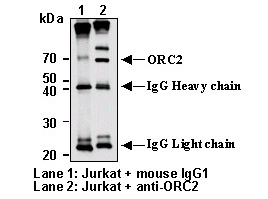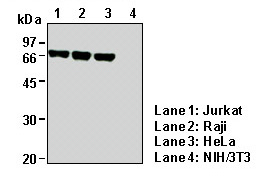Anti-ORC2 (Human) mAb
| Code | Size | Price |
|---|
| MBL-M055-3 | 100 ug | £323.00 |
Quantity:
Prices exclude any Taxes / VAT
Overview
Host Type: Mouse
Antibody Isotype: IgG1 κ
Antibody Clonality: Monoclonal
Antibody Clone: 3B7
Regulatory Status: RUO
Target Species: Human
Applications:
- Immunocytochemistry (ICC)
- Immunoprecipitation (IP)
- Western Blot (WB)
Shipping:
4°C
Storage:
-20°C
Images
Documents
Further Information
Applications:
WB - 1 ug/mL (chemiluminescence detection system) IP - 5 ug/600 uL of cell extract from 5x106 cells ICC - 10 ug/mL
Background:
In yeast Saccharomyces cerevisiae, DNA replication initiates from specific DNA sequences called autonomous replication sequences (ARSs), many of which have proven to be chromosomal origins of replication. A six-subunit protein complex named ORC (origin recognition complex) identified initially as ARS binding activity in an ATP-dependent manner. Because ORC remains bound to ARS throughout the cell cycle, initiation of replication, at least in S. cerevisiae, is not regulated by simply controlling the binding of ORC to origins but is thought to be due to the ORC dependent recruitment of other proteins such as MCMs onto the chromosome. Also, ORC may play a role in transcriptional "silencing" (Repression of transcription that appears to be due to a specialized chromatin structure) in S. cerevisiae mainly by recruiting the silencing apparatus. A silent chromatin share many properties of heterochromatin in Drosophila that is highly condensed state of chromatin where ORC might act in the formation or maintenance through interactions with heterochromatin-organizing factors. In higher eukaryotes, the replication origins have been more difficult to characterize at the molecular level. Recent study reported that the distance between chromatin-bound human ORC2 protein and chromatin-bound human MCM proteins must be at least 500-1,000 base pairs in HeLa cells. It is different from the case of yeast in which the distance between ORC and MCMs might be much smaller. ORC2 is a second largest subunit of ORC and its specific feature is largely remained unclear.
Concentration:
1 mg/mL
Formulation:
100 ug IgG in 100 ul volume of PBS containing 50% glycerol, pH 7.2. No preservative iscontained.
Gene IDs:
Human: 4999 Mouse: 18393
Immunogen Translated:
Recombinant human ORC2 (1-577aa.)
Reactivity:
This antibody detects ~67 kDa of human ORC2 on Western blotting, Immunoprecipitation and Immunocytochemistry.
Shelf Life:
1 year
Source:
This antibody was purified from mouse ascites fluid using protein A agarose. This hybridoma was established by fusion of mouse myeloma cell P3U1 with Balb/c mouse splenocyte immunized with full-length human ORC2 fusion protein (1-577 aa).
Target:
ORC2
References
1) Thangavel, S., et al., Mol. Cell. Biol. 30, 1382-1396 (2010)
2) Tatsumi, Y., et al., Genes Cells 13, 1045-1059 (2008)
3) Hashiguchi, K., et al., Nucleic Acids Res. 35, 2913-2923 (2007)
4) Ohta, S., et al., J. Biol. Chem. 278, 41535-41540 (2003)
5) Tatsumi, Y., et al., J. Biol. Chem. 278, 41528-41534 (2003)
6) Sato, N., et al., Genes Cells 8, 451-463 (2003)
7) Takayama, M. A., et al., Genes Cells 5, 481-490 (2000)
8) Shirahige, K., et al., Nature 395, 618-621 (1998)
9) Tanaka, T., et al., EMBO J. 17, 5182-5191 (1998)
10) Ritzi, M., et al., J. Biol. Chem. 273, 24543-24549 (1998)
11) Dillin, A., et al., Science 279, 1733-1737 (1998)
12) Lustig, A. J., et al., Curr.Opin.Genet.Dev. 8, 233-239 (1998)
13) Pak, D.T., et al., Cell 91, 311-323 (1998)
14) Sherman, J.M., et al., Trends Genet. 13, 308-313 (1997)
15) Gavin, K.A., et al., Science 270, 1667-1671 (1995)
16) Diffley, J.F., et al., Nature 357, 169-172 (1992)
Clone 3B7 is used in the reference number 1)-7).





